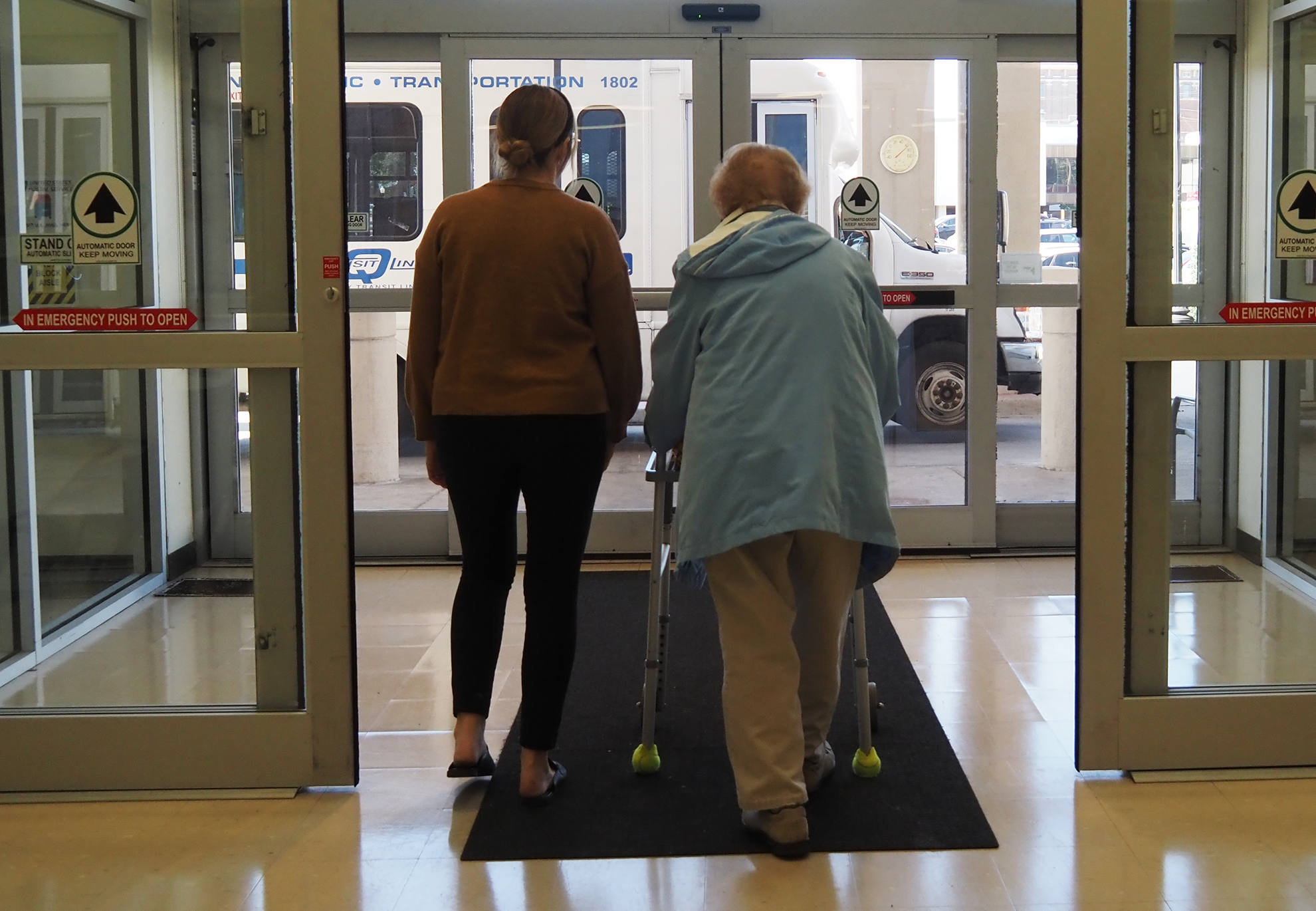‘Aging is a bipartisan issue’: Day of Action set for Wednesday as Quincy seniors prepare for federal budget cuts

QUINCY — The Older Americans Act (OAA), passed by Congress in 1965 under President Lyndon B. Johnson, established several programs and services that have become crucial to the nation’s aging population.
Funding for the OAA and other programs vital to older Americans now is being threatened by widespread federal budget cuts that have already been executed by the Department of Government Efficiency and further stalled by inaction in Congress.
Even more severe budget cuts are outlined in the 1,116-page “One Big Beautiful Bill Act,” which narrowly passed the U.S. House of Representatives by a 215-214 vote after a 21-hour Rules Committee hearing on the bill, which began at the unusually early hour of 1 a.m. last Wednesday. The bill heads to the Senate next, where its fate is uncertain.
The bill outlines significant cuts to Medicaid and the Supplemental Nutrition Assistance Program (SNAP), programs relied upon by millions of Americans — especially the impoverished, disabled and aging.
“Aging is a bipartisan issue, so it doesn’t matter who you vote for, who the president is,” said Vanessa Keppner, director of the West Central Illinois Area Agency on Aging.
Keppner says the loss of federal funding across the board is likely to result in a reallocation of state funding, which she anticipates will force the agency to cut some of its services.
As Keppner and her team consider what programs to prioritize and how to continue serving the same volume of people who have come to rely on their services, the agency is bracing for impact. Cutting of services and programs could leave local seniors with even fewer lifelines, with costs and care responsibilities likely shifting to family members, local nonprofits or churches.
“(People in the community) need to be aware, and they need to voice their opinions so that it doesn’t end up looking this way,” Keppner said.
A “Day of Action” in support of the OAA and preserving senior support has been organized for 11 a.m. Wednesday at the Quincy Senior & Family Resource Center, 639 York.
“It’s not just for seniors. It’s about caregivers and young adults as well,” she said. “This is affecting their future. Even if you’re not using our services, you should be aware and able to advocate for aging.”
Crucial programs, services at risk for local seniors
“Everybody is aging. It’s a luxury to be able to age, and it’s a luxury to be able to age in place and at home,” Keppner said. “The aging services that we provide are the lifelines for older adults to be able to do that.”
The Area Agency on Aging offers numerous OAA-funded services throughout the six counties it serves — Adams, Brown, Calhoun, Hancock, Pike and Schuyler — such as:
- Adult daycare
- Caregiver support
- Affordable housing, assisted and supportive living facilities and home care services
- Meals on Wheels home delivery service and congregate meals at 12 serving sites
- Transportation
- Exercise programs
- Adult protective services
- Legal assistance
- Tax assistance
- Employment programs
Keppner said the agency tries to focus on reaching people who fall below the federal poverty line, but anyone age 60 and older is eligible for services.
The agency’s most utilized services are its meal programs. Throughout fiscal year 2023, 124,895 meals were delivered, and nearly 30,000 meals were served at the agency’s 12 congregate meal sites.
Keppner said the programs have already been affected by recent cost increases for food and the materials needed to serve and transport it. The styrofoam meal containers used for home-delivered meals are sourced from out of the country and have been impacted by tariffs.
The Quincy Senior & Family Resource Center serves as a hub of many of these resources, but it’s also used as a community event space. A group of teenagers recently utilized the center to host a dance party on a day off from school last fall.

Aspen Gengenbacher
The OAA must be reauthorized every so often, giving lawmakers the opportunity to make improvements and adjust funding levels as needed. It was last reauthorized by Congress and signed into law by President Donald Trump in March 2020, funding it through the end of fiscal year 2024.
U.S. Sen. Bernie Sanders, an Independent from Vermont, introduced the Older Americans Act Reauthorization Act in July 2024 to renew the OAA’s funding through fiscal year 2029. It was co-sponsored by Sen. Tim Kaine of Virginia and Sen. Edward Markey of Massachusetts, both Democrats, and Sen. Susan Collins of Maine and Sen. Lisa Murkowski of Alaska, both Republicans.
The Reauthorization Act called for an overall expansion of the OAA, including a 20 percent funding increase, further caregiver support and improvements to the Long-Term Care Ombudsman program. As the Baby Boomer generation continues to increase the nation’s aging population, further investments in the OAA would have positioned hundreds of state, regional and tribal agencies on aging and thousands of service providers to address the growing demand for its services and programs.
It passed unanimously in the Senate but failed to pass in the House before the end of the legislative session. It has yet to be reintroduced in either chamber. A continued appropriations bill was approved by Congress in March 2025, extending the OAA’s funding to September.
Unless new legislation is introduced to reauthorize the program, its funding could expire in a matter of months, leaving states responsible for making up the difference when federal spending cuts across the board are already forcing them to incur significant financial burdens they’re unlikely to afford.

Aspen Gengenbacher
“We’re really lucky here in Illinois, because a lot of our funding does come from the state, but it’s not enough to keep the program alive,” Keppner said. “The federal funding — we need that to keep it operational.”
The Illinois Association of Area Agencies on Aging says nearly 500,000 older Illinoisans received services funded by the OAA throughout fiscal year 2024. Without federal support, the agency estimates that hundreds of thousands of services will be lost each month, such as:
- 183,209 home delivered meals
- 154,71 congregate meals
- 14,933 rides
- 5,378 health screenings and education
- 925 in-home and chore services
- and 753 family caregiver services.
Restructuring likely to result in severe disruptions without long-term improvements
Keppner said the majority of the Area Agency on Aging’s services haven’t been impacted yet, but she’s concerned by the recent dismantling of the Administration for Community Living (ACL), which administers funding for various programs that support older and disabled populations.
The Department of Health and Human Services (HHS) has said the funding wouldn’t necessarily disappear without the ACL, but it would be reallocated to other HHS agencies. However, the HHS has yet to explain how other agencies would absorb the administrative responsibility, especially after the recent firing of 10,000 full-time HHS employees and the shuttering of half of the department’s regional offices.
Keppner said such a restructuring would further complicate and significantly delay access to services. She isn’t optimistic that such severe disruptions will result in long-term improvements.
The delays and uncertainty make budgeting an even more difficult task, not only for Keppner’s agency but also for clients on fixed incomes, as Medicaid cuts could affect the cost of their medications and SNAP cuts could affect the cost of their groceries.
“That really impacts their independence,” Keppner said. “If we’ve got people waiting for services, then they’re potentially not going to be self-sufficient in the community.”
A lack of independence often results in placement in nursing homes and skilled nursing facilities, which Keppner said ends up “costing the taxpayer even more than it would to focus the funding on our aging services.”
Nearly $300 billion in cuts to SNAP and $900 billion in cuts to Medicaid are projected during the next 10 years if the “One Big Beautiful Bill Act” passes in the Senate as is. The non-partisan Congressional Budget Office (CBO) projects 3.2 million people losing food assistance each month and as many as 13.7 million people losing health insurance over the next decade.
Roughly one in eight seniors and one in five children in Adams County received health coverage under Medicaid in 2023, and roughly 16 percent of county residents receive Medicare.
The Center for Medicare Advocacy says roughly two-thirds of nursing home residents rely on Medicaid, which provides long-term and in-home care for elderly Americans, to cover their stay. The agency estimated that the cuts to Medicaid would severely impact nursing home workers, “whose wages are so low that many are eligible for and rely on Medicaid for their own health care and the health care of their families.”

Aspen Gengenbacher
The CBO estimated the bill’s ramifications to the federal deficit would force more than $500 billion in Medicare cuts by 2034.
Nearly one in five SNAP recipients were seniors in fiscal year 2022. Less than half of eligible seniors are estimated to utilize their SNAP benefits, potentially due to a lack of awareness, a complicated and tech-reliant application process or difficulty accessing assistance.
Despite such significant losses for impoverished and working-class Americans across all stages of life, the Wharton School of the University of Pennsylvania, Trump’s alma mater, estimates the bill to add nearly $3 trillion to the primary deficit over the next decade. It also estimates that the top 10 percent of income earners will benefit from roughly 70 percent of the bill’s total value, and that “lower-income households and some in the middle class are worse off.”
The lowest earners are projected to lose more than $800 in 2026. They’ll lose even more in 2033, with over $1,500 in losses. The highest earners are projected to gain more than $100,000 in 2033, but will see even larger gains in the short term (nearly $400,000 in 2026). The middle class will see menial gains, with the highest in 2026 of $3,000 and landing around $2,200 in 2033.
Several of the bill’s provisions that are more popular at face value, such as no tax on tips, overtime and auto loans and various tax deductions and credits, are set to expire in 2028 — less than a month before Trump leaves office. Savings spurred by economic growth aren’t expected until at least 2033, and “are not enough to overcome higher costs in earlier years.”
The overall fiscal impact isn’t far off from those incurred under the Obama and Biden administrations. However, unlike previous incursions that occurred as a result of expansions to safety net programs, the “One Big Beautiful Bill Act” shrinks them — and still increases the deficit.
Instead of spending increases, massive tax cuts for earners with annual incomes of more than $4.3 million are considered to be the primary driver of the bill’s impacts to the deficit.
The bill is unlikely to pass as is in the Senate, where Republicans hold a narrow majority. Several Republican Senators have expressed concern: Sen. Ron Johnson of Wisconsin referred to the bill as “the Titanic” in reference to its impacts to the deficit, claiming it would “leave our children mortgaged;” Sen. Rand Paul of Kentucky also disapproved of the bill’s impacts to the deficit, calling the cuts “wimpy and anemic” and stating that the bill as is “would explode the debt;” and Sen. Josh Hawley of Missouri published an op-ed in The New York Times in defense of protecting Medicaid funding earlier this month.
Any changes made in the Senate will require the bill return to the House for final approval, where its odds of passing through the House a second time are equally uncertain. Two Republican Representatives sided with Democrats in voting against it and one voted present last week.
Miss Clipping Out Stories to Save for Later?
Click the Purchase Story button below to order a print of this story. We will print it for you on matte photo paper to keep forever.

